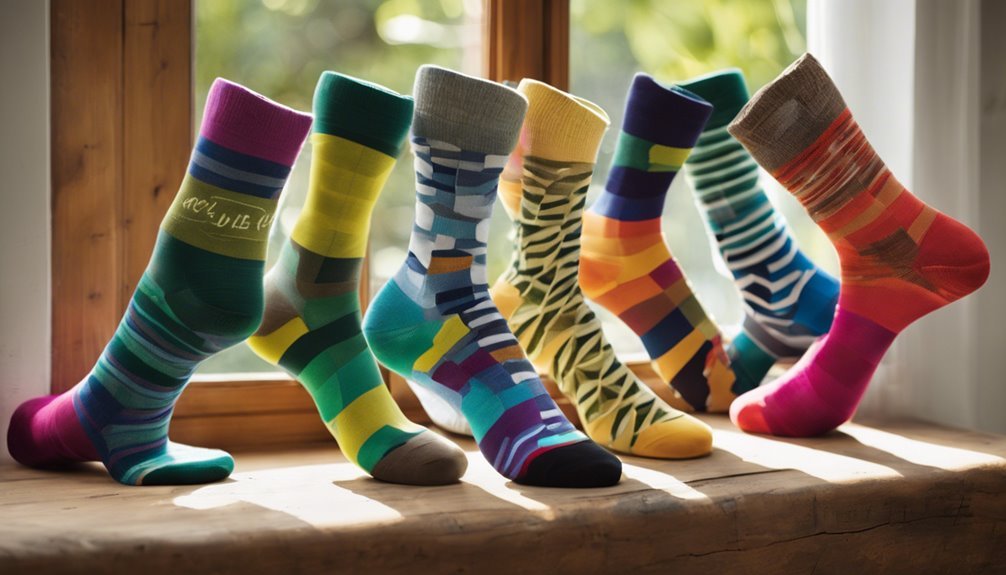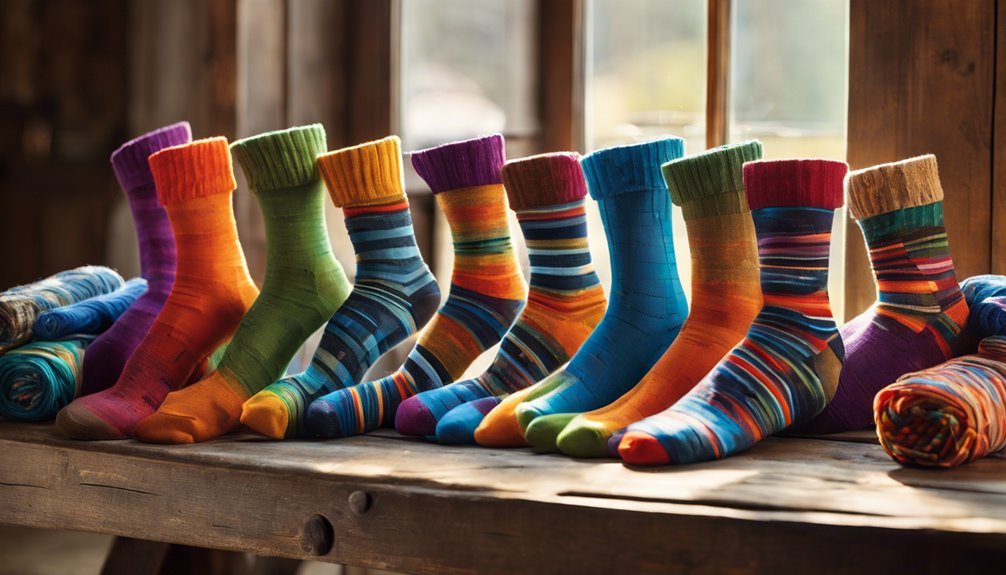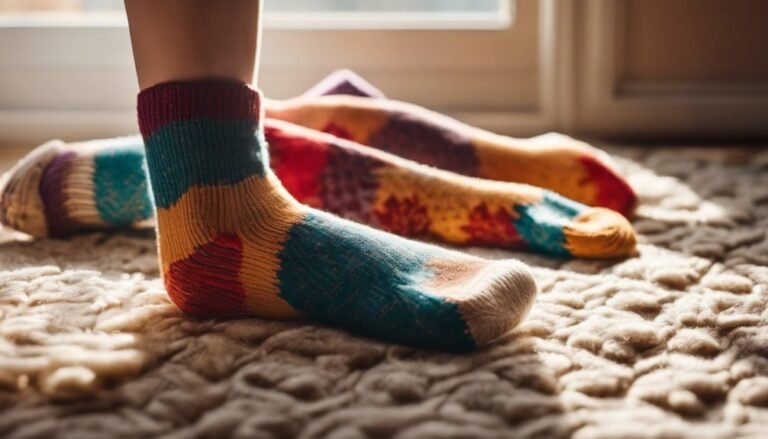How Recycled Materials Are Changing the Sock Industry
Recycled materials are transforming the sock industry by prioritizing sustainability and reducing waste. Brands are crafting socks from recycled polyester, cotton, and even nylon sourced from fishing nets. These eco-friendly options not only lower your carbon footprint but also enhance comfort and style. Your choice reflects a commitment to ethical practices and circular economies. As consumer demand for green products grows, exciting innovations are emerging in sock design and production. There's much more to discover about this evolution.
The Rise of Sustainable Socks

As consumers become more environmentally conscious, the rise of sustainable socks is reshaping the fashion landscape. You might not realize it, but socks are a vital part of the sustainable fashion movement. Brands are now prioritizing eco-friendly materials, like organic cotton and bamboo, which reduce the environmental impact of production. These socks not only offer comfort but also align with your values of freedom and responsibility. Choosing sustainable socks means supporting ethical practices and reducing waste. However, it's important to stay critical; not all brands are transparent about their methods. By being informed, you can make choices that truly reflect your commitment to sustainability while enjoying stylish, durable socks that benefit the planet. Freedom in fashion starts with your choices.
What Are Recycled Materials?
When you think about recycled materials, it's important to recognize the various types that can be used in products like socks. From reclaimed plastics to repurposed cotton, these materials not only reduce waste but also offer significant environmental benefits. Understanding what recycled materials are can help you make more informed choices in your sustainable fashion journey.
Types of Recycled Materials
Recycled materials play an essential role in the sock industry, transforming waste into functional and stylish products. You'll find a variety of recycled fibers, such as post-consumer plastics, cotton scraps, and even discarded textiles, all contributing to innovative sock designs. These materials not only reduce landfill waste but also encourage a circular economy. Additionally, many brands are opting for eco-friendly dyes that minimize environmental impact, ensuring that even the color choices you make are sustainable. By choosing socks made from recycled materials, you're actively supporting a movement toward responsible consumption and environmental awareness. So, next time you slip on a pair of socks, remember that your choice can reflect your values and promote a more sustainable future.
Environmental Benefits Explained
Choosing socks made from recycled materials not only supports sustainable fashion but also carries significant environmental benefits. By opting for these socks, you're actively participating in sustainable practices that reduce waste and conserve resources. It's a powerful way to elevate your environmental awareness while enjoying stylish comfort.
Recycled materials often require less energy to produce compared to virgin materials, cutting down on greenhouse gas emissions. Plus, these practices help divert plastic and textiles from landfills, promoting a circular economy. When you choose recycled socks, you're not just making a fashion statement; you're embracing a lifestyle that prioritizes our planet's health. So, wear your socks with pride, knowing you're contributing to a more sustainable future.
Types of Recycled Materials Used in Socks
As the demand for sustainable fashion grows, the sock industry is increasingly incorporating a variety of recycled materials to appeal to eco-conscious consumers. You might be surprised by the range of recycled fibers being used, including:
- Recycled Polyester: Derived from plastic bottles, it reduces waste and utilizes sustainable sourcing.
- Recycled Cotton: Perfect for those seeking comfort while minimizing water usage.
- Nylon from Recycled Fishing Nets: This innovative approach helps clean oceans while creating durable socks.
- Merino Wool from Recycled Textiles: Offering warmth and performance, it promotes a circular economy.
Benefits of Wearing Recycled Socks
When you choose recycled socks, you're making an eco-friendly footwear choice that helps reduce waste and environmental impact. Not only do these socks offer enhanced comfort and durability, but they also support sustainable practices in the fashion industry. By wearing recycled socks, you're taking a step toward a more responsible and stylish lifestyle.
Eco-Friendly Footwear Choice
Although many may not realize it, wearing recycled socks can greatly impact both personal comfort and the environment. By opting for eco-friendly options, you're making a statement that supports sustainability. Here are four benefits of choosing recycled socks:
- Reduced Waste: Recycled materials divert waste from landfills, promoting a cleaner planet.
- Conservation of Resources: Using sustainable materials decreases the demand for virgin resources, preserving our natural environment.
- Lower Carbon Footprint: Manufacturing recycled socks typically requires less energy, reducing greenhouse gas emissions.
- Support for Ethical Brands: Many companies producing recycled socks prioritize ethical labor practices, aligning your choices with your values.
Incorporating these eco-friendly options into your wardrobe not only feels good but also contributes positively to the world around you.
Enhanced Comfort and Durability
Choosing recycled socks doesn't just benefit the environment; it also enhances your comfort and durability. These socks are crafted from breathable fabrics that allow air to flow, keeping your feet fresh and reducing sweat buildup. With advanced moisture management, they wick away perspiration, ensuring you stay dry during even the most active days. You won't have to worry about discomfort or blisters, as the soft materials provide a cushioned feel without compromising on strength. Plus, recycled socks often maintain their shape and resilience, making them a long-lasting addition to your wardrobe. It's time to step into a pair that offers not just style but a true sense of freedom and support for your feet. Why settle for less?
Supporting Sustainable Practices
By opting for recycled socks, you're not just treating your feet to comfort; you're also making a significant contribution to sustainable practices. Wearing socks made from sustainable materials promotes ethical sourcing and reduces waste. Here are some benefits you'll enjoy:
- Environmental Impact: Every pair saves resources and minimizes landfill waste.
- Support for Ethical Brands: You're backing companies that prioritize transparency and ethical sourcing.
- Quality Assurance: Recycled socks often boast durability and comfort, promoting long-lasting use.
- Awareness & Advocacy: By choosing recycled, you're encouraging others to contemplate sustainable options.
When you wear recycled socks, you embrace freedom in personal choice while championing a healthier planet. It's a small step that leads to significant change!
Leading Brands Embracing Sustainability

As consumers become more aware of environmental issues, leading brands in the sock industry are stepping up to embrace sustainability by incorporating recycled materials into their products. These brands aren't just making socks; they're redefining their marketing strategies to highlight eco-friendliness. Through innovative brand collaborations, they're amplifying their message and appealing to a more conscious audience. Think about it: when you purchase sustainably made socks, you're supporting a movement towards a greener future. However, it's crucial to scrutinize these brands' claims. Are they genuinely committed, or just jumping on the bandwagon? As you choose your next pair, consider how these companies are balancing profit with purpose. Your choices can drive the demand for sustainable practices in the sock industry.
Challenges in Sourcing Recycled Materials
While the push for sustainability in the sock industry is commendable, sourcing recycled materials presents significant challenges that can complicate these efforts. You might not realize just how complex it can be. Here are some recycled sourcing challenges you should know about:
- Material Availability Issues: Sourcing sufficient quantities of quality recycled materials can be tough.
- Inconsistent Supply Chains: Fluctuations in the supply of recycled materials can disrupt production timelines.
- Quality Control: Ensuring recycled materials meet performance standards is often a challenge.
- Cost Implications: Sometimes, recycled materials can be more expensive than virgin options, impacting pricing.
These hurdles make it clear that while sustainability is the goal, the journey toward it isn't straightforward.
Consumer Demand for Eco-Friendly Products
You've likely noticed a shift in what consumers are looking for, with more people prioritizing eco-friendly options in their purchases. The rise of sustainable fashion is driving this trend, as shoppers increasingly seek brands that align with their values. As a result, the sock industry is feeling the pressure to adapt to these changing purchasing habits, making recycled materials a key focus for many manufacturers.
Growing Eco-Conscious Consumer Base
How do shifting values influence what consumers choose to wear? As eco-conscious trends rise, you're likely noticing a demand for sustainable consumerism in everyday fashion, including socks. You want products that reflect your values, and that's changing the game. Here's how:
- Environmental Awareness: You're more informed about how your choices impact the planet.
- Quality Over Quantity: You prefer investing in durable, recycled materials rather than fast fashion.
- Brand Transparency: You look for companies that openly share their sustainable practices.
- Community Engagement: You seek brands that support local initiatives and ethical labor.
With this shift, the sock industry is adapting, and your purchasing power is driving change toward a greener future.
Influence of Sustainable Fashion
The rise of eco-conscious consumerism has sparked a significant shift in the fashion landscape, particularly in the demand for eco-friendly products. You're not just looking for trendy styles; you want sustainable fashion that aligns with your values. This growing desire for eco-friendly materials means brands must adapt or risk losing your loyalty. Socks made from recycled fibers are a prime example of how innovative companies are responding to your needs. By prioritizing sustainability, you're not only making a statement with your wardrobe but also influencing the industry to embrace greener practices. Your choices matter, and as more people seek out sustainable options, the sock industry will continue to evolve, paving the way for a more responsible future in fashion.
Shift in Purchasing Habits
As consumers become increasingly aware of the environmental impact of their purchases, a notable shift in buying habits is emerging, particularly in the sock industry. You're not just looking for comfort anymore; you're prioritizing sustainability. This change is reflected in four key shopping trends:
- Increased Demand: Eco-friendly socks made from recycled materials are becoming must-haves.
- Brand Loyalty: Consumers prefer brands that align with their values of sustainability.
- Price Sensitivity: You're willing to invest a bit more for ethically produced products.
- Awareness Campaigns: Brands are promoting their eco-initiatives, influencing consumer preferences.
This shift isn't just a trend; it's a movement toward more conscious consumerism, empowering you to make choices that reflect your values.
Innovations in Sock Design and Production

While you might think of socks as simple garments, innovations in their design and production are transforming the industry in remarkable ways. The integration of sustainable textiles and innovative designs is reshaping how you think about comfort and style. Brands are now utilizing recycled materials to create socks that don't just feel good but also promote environmental consciousness.
| Feature | Description |
|---|---|
| Moisture-Wicking | Keeps feet dry and comfy |
| Eco-Friendly Materials | Made from recycled plastics |
| Advanced Cushioning | Enhances comfort |
| Customizable Designs | Personalizes your style |
These advancements not only elevate your sock game but also contribute positively to the planet, making each pair a choice you can feel good about.
The Impact of Recycling on the Environment
When you choose products made from recycled materials, you're not just opting for sustainability; you're actively participating in a larger movement toward environmental restoration. The impact of recycling processes on our planet is profound and multifaceted. Here's how your choice matters:
- Reduces waste: Less trash ends up in landfills.
- Conserves resources: Decreases the need for raw materials.
- Saves energy: Recycling uses considerably less energy than production from scratch.
- Promotes environmental awareness: Your actions inspire others to contemplate eco-friendly options.
The Future of Sustainable Sock Manufacturing
The shift toward recycling in the sock industry is just the beginning of a broader movement toward sustainable manufacturing practices. As you explore the future, you'll see an increasing demand for sustainable materials that not only reduce waste but also promote ethical manufacturing. Brands are starting to prioritize transparency, ensuring that their sourcing and production processes respect both the environment and labor rights. This isn't just a trend; it's a call for freedom from harmful practices. You'll discover innovative textiles made from recycled plastics and organic fibers, setting a new standard. The future of sock manufacturing isn't just about comfort; it's about making choices that align with your values, paving the way for a more responsible and liberated fashion landscape.
Frequently Asked Questions
How Do Recycled Socks Compare in Quality to Traditional Socks?
When you slip on recycled socks, you might feel the dance of innovation beneath your feet. Their durability comparison to traditional socks often surprises, as thoughtful material sourcing brings comfort and resilience together, creating a sustainable choice.
Can Recycled Socks Be Recycled Again After Use?
Yes, recycled socks can be recycled again after use, enhancing socks sustainability. The recycling process involves breaking down materials, allowing new products to emerge. This cycle promotes environmental responsibility and freedom from wasteful practices, benefiting both you and the planet.
Are Recycled Socks More Expensive Than Regular Socks?
Recycled socks often have a higher cost due to the materials and processes involved. However, market trends show increasing demand, making them more competitive. It's worth considering the environmental benefits alongside that cost comparison.
How Do I Properly Care for Recycled Socks?
Caring for your recycled socks is like nurturing a garden; gentle sock washing is key. Stick to eco-friendly practices, like cold water and air drying, to keep them fresh and sustainable for your feet and the planet.
What Certifications Should I Look for in Recycled Socks?
When shopping for recycled socks, look for eco-friendly certifications like Global Recycle Standard or OEKO-TEX. These guarantee the recycled materials meet strict environmental and safety standards, giving you confidence in your sustainable fashion choices.






